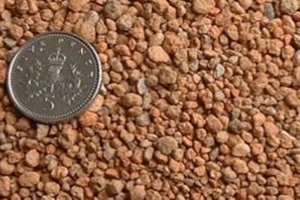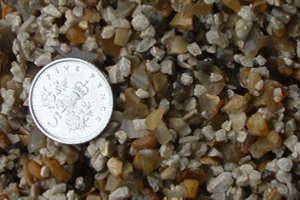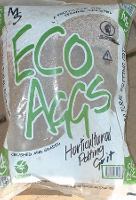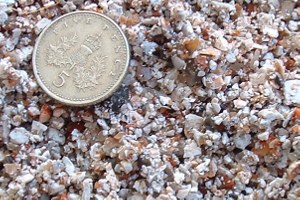Drainage and Soil Aeration.
The key to providing good drainage and aeration is to provide voids of the right size in the mix, both to retain air and allow excess water to drain out. Just as in nature, this is achieved by having the right ratio of large and small particles. For example if there were too many small particles they would simply fill the gaps between the bigger particles leaving very small air pockets which would retain excess water. Similarly, if too little grit was added the particles would not rest against each other so creating the voids.
There are numerous commercial products available that can be added to compost mixtures to ensure good drainage, ranging from traditional horticultural grit to the quite unusual, some of the latter are gaining favour with some growers.
Perlite.
Perlite is generic term for naturally occurring siliceous rock. The key feature of perlite is that when heated to a suitable point in its softening range, it expands from four to twenty times its original volume. This expansion is due to the presence of two to six percent combined water in the crude perlite rock. When quickly heated to above 871°C, the crude rock pops like popcorn as the combined water vaporizes and creates countless tiny bubbles which account for the light weight and other exceptional physical properties of expanded perlite. This expansion process also creates one of perlite's most distinguishing characteristics: its white color. While the crude rock may range from transparent light gray to glossy black, the color of expanded perlite ranges from snowy white to grayish white. Expanded perlite is exceptionally light and is classified as chemically inert and is pH neutral.
Vermiculite.
Vermiculite is the mineralogical name given to hydrated laminar magnesium-aluminum-iron silicate which resembles mica in appearance. When subjected to heat vermiculite has the unusual property of exfoliating or expanding into worm-like pieces (the name vermiculite is derived from the Latin 'vermiculare' - to breed worms).This characteristic of exfoliation, the basis for commercial use of the mineral, is the result of the mechanical separation of the layers by the rapid conversion of contained water to steam. The increase in bulk volume of commercial grades is 8 to 12 times, but individual flakes may exfoliate as many as 30 times. There is a color change during expansion that is dependent upon the composition of the vermiculite and furnace temperature.
Lightweight Expanded Clay Aggregate.
Lightweight expanded clay aggregate is a special type of clay that has been pelleted and fired in a rotary kiln at a very high temperature. As it is fired, the organic compounds in the clay burn off forcing the pellets to expand and become honeycombed while the outside surface of each granule melts and is sintered. The resulting ceramic pellets are lightweight, porous and have a high crushing resistance. The added advantage here is it's ability to absorb and release nutrients. Many sources and in particularly Bonsai growers are reporting that some types of supermarket cat litter are suitable alternative providing it is washed well to remove the perfume first.
The pink clay below is known as Danish Molar Clay. A word of warning, some types of cat litter are made from recycled wood and paper and
sometimes referred to as 'clumping', this material is not suitable.
LECA also makes an appearance as
spillage absorption granules and is available by the pallet from safety equipment suppliers.
 |

|
Cat Litter(LECA). |
Pigeon Grit. |
Pigeon Grit.
I have also used pigeon grit which is a smaller aggregate than hen grit. Avoid that which contains crushed shell. I tend to use the grit shown below as a top dressing.
Recycled Ceramic Material.
One product that has made an appearance in some garden centers recently is potting grit which is a waste product of the ceramics industry and is not too expensive. From the limited tests that I have carried out,it is pH neutral and it contains no salt.
 |
 |
Eco Aggs |
|
Pots and Containers.
There are many containers available and the choice is pretty much a personal one. The same criteria as that for soil should apply - free draining. Unglazed clay pots have the distinct advantage of drying out faster than plastic pots and are the preferred choice for plants kept outside which may be subject to heavy rain from time to time in the U.K. On the flip side large clay pots can become quite heavy.
The drainage holes in most pots and planters are merely a token gesture and are inadequate for the UK climate. If necessary additional holes can be made. To ensure proper drainage, ensure that the drainage holes do not become blocked with soil from above, coarse aggregate material can be added to the bottom of the pot up to 10% of the depth of the pot. If there is a tendency for the drainage material to fall out of the holes in the pot, a layer of plastic netting can be used, the type used for prepackaged oranges in the supermarket is ideal for this purpose.
Some people recommend having uniform soil composition throughout the whole pot to guard against a perched water table, this can only work if pots are on capillary matting or plunged into sand. I prefer to keep my outdoor pots off the ground to help keep out the wildlife. For young plants and seedlings where capillary matting is used to provide watering, no drainage material should be placed in the bottom of the pot as this would impede the capillary action that draws water up from the matting into the soil.
For plants kept in the greenhouse where watering can be better controlled, plastic pots are inexpensive, easier in your back and less likely to dry out too quickly.
Pot Styles
The style of pot used will be determined by the growth habit of the plant. Some of the smaller specimens only put out a shallow spreading root run so deep pots offer no advantage. As the plants grow, repotting will be necessary to provide scope for further growth. This is best carried out at the start of the growing season just before the plant puts out new roots, this minimises damage to active roots and provides fresh soil at the right time. To prevent excess evaporation from the soil surface a top dressing of grit can be applied, this also gives a better appearance to the finished item.
On the next page we take a look at feeding.




